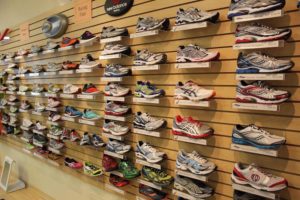With NYRR announcing the cancellation of the 2020 NYC marathon, “Run for Your Life” participants will be focusing more on strength training and injury prevention. Saturday morning’s Run for Your Life training will begin at 8 am in front of the George Rosenfeld Center for Recovery (GRCR) on Wards Island.
Don’t forget to join us on Strava for our weekly training goals! Saturday morning’s run will begin this week’s goal – 28 miles in 5 days – with a 6-mile tempo run.
STAY TUNED FOR THE ODYSSEY HOUSE “RUN FOR YOUR LIFE” VIRTUAL 5K FUNDRAISER COMING IN SEPTEMBER!!
7 tips on how to select a sneaker when faced with a wall of options:

1. Current Fitness Level and Your Future Aspirations.
Two questions you should ask yourself “are you training for something?” and “what’s the distance that you’re training for?” It is important to understand how you have used your shoes in the past and what you intend to use them for in the future. For example, a new runner or low mileage runner (10- 20 miles a week) most likely should go with a more protective sneaker to minimize the risk of injury; runners in this phase are still figuring out their form. Medium-mileage runners (20 to 40 miles a week) and high mileage runners (40+ miles a week) should select a sneaker based on past experiences with performance durability, stability, and cushioning.
2. Injuries: Cause and Effect
Two more important questions “are you currently injured?” and “do you have a history of injuries?” The type of injury you have may help determine if there is a correlation with the running shoes. Also, with former injuries, you do want to err on the side of caution. Seek an expert to help recommend something with better structural support for your type of injury.
3. Your Natural Gait
Understanding your gait and running style is the most important thing that you can do when buying new running shoes. You want to maintain proper alignment as you and it all starts with the feet. Some running stores will perform a complimentary gait analysis for you, watching you walk and run while both barefoot and wearing a pair of neutral sneakers to see what your feet and ankles do mid-stance.
Gaits typically fall into three standard types: neutral, over-pronated, or under-pronated. A neutral gait means a person’s hips knees and ankles are all in alignment and their arch only flexes a little. An over-pronated foot rolls too far inward and would benefit from a stabilizing shoe. An under-pronated foot rolls out and requires more cushioning.
4. Spacing
You actually want to make sure you have a full thumbnail’s worth of empty space in the front of the shoe when you first try it on. It is common to find people who wear their running shoes way too snug. Naturally, when you run, your feet swell and expand; your sneaker should be able to accommodate for the swelling.
5. The Soft Roll Out
To avoid unnecessary foot pain, it is important to work your new shoes slowly into your current running routine. Start by wearing your new sneakers for only 20-30 percent of your weekly mileage, and gradually increase that number as you phase out your old pair to avoid blisters and other foot pains.
6. More than the Flash
The most important component of a running shoe is the midsole because it is where the primary form of cushioning and support is located. Many people tend to pay attention to the upper portion of fabric, but that is really just keeping your foot in the shoe. The condition of the midsole is often how you can tell if it is time to replace your existing pair of running shoes. If you see any cracking or wrinkling, it is time to replace those kicks.
7. How Does It Feel?
The best shoe is the shoe that is specifically tailored to your foot, support and cushion wise. There is no one shoe that is the best shoe, but there is the one shoe that is best for you. Four popular brands in specialty running are Brooks, Saucony, Mizuno, and Asics, and are often a great place to start if you are new to running and on the hunt for that perfect stride.
Source: Hall, Alena; Healthy Living: 7 Important things to know when buying running shoes
Coach Andre’s tips:
After weekend long runs, be sure to take time out for a long, hot bath to soothe and relax tense muscles and alleviate joint soreness. I also recommend a monthly deep muscle tissue massage which helps to remove lactic acid build up and assists with oxygenated blood flow.

